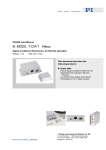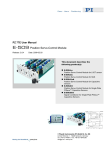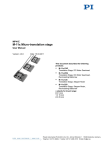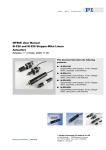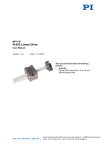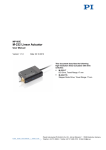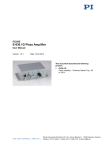Download - Physik Instrumente
Transcript
PZ180E User Manual E-852 PISeca™ Signal Conditioner Electronics Release: 1.2.0 Date: 2009-02-10 This document describes the following products: E-852.10 PISeca™ Signal Conditioner Electronics for SingleElectrode Capacitive Sensors 1 Channel © Physik Instrumente (PI) GmbH & Co. KG Auf der Römerstr. 1 ⋅ 76228 Karlsruhe, Germany Tel. +49 721 4846-0 ⋅ Fax: +49 721 4846-299 [email protected] ⋅ www.pi.ws Physik Instrumente (PI) GmbH & Co. KG is the owner of the following company names and trademarks: PI®, PIC®, PICMA®, PILine®, PIFOC®, PiezoWalk®, NEXACT®, NEXLINE®, NanoCube®, NanoAutomation® Copyright 1999–2009 by Physik Instrumente (PI) GmbH & Co. KG, Karlsruhe, Germany. The text, photographs and drawings in this manual enjoy copyright protection. With regard thereto, Physik Instrumente (PI) GmbH & Co. KG reserves all rights. Use of said text, photographs and drawings is permitted only in part and only upon citation of the source. First printing 2009-02-10 BSc, BRo Document Number PZ180E, Release 1.2.0 E-852_User_PZ180E120.doc Subject to change without notice. This manual is superseded by any new release. The newest release is available for download at www.pi.ws (http://www.pi.ws). About this Document Users of this Manual This manual is designed to help the reader to install and operate the E-852 PISeca™ Signal Conditioner Electronics. It assumes that the reader has a fundamental understanding of capacitive measurement systems, as well as applicable safety procedures. The manual describes the physical specifications and dimensions of the E-852 PISeca™ Signal Conditioner Electronics as well as the hardware installation procedures which are required to put the associated sensor system into operation. Updated releases are available for download from www.pi.ws or via email: contact your Physik Instrumente Sales Engineer or write [email protected]. Conventions The notes and symbols used in this manual have the following meanings: CAUTION Calls attention to a procedure, practice, or condition which, if not correctly performed or adhered to, could result in damage to equipment. NOTE Provides additional information or application hints. Related Documents The sensors and any further tools which might be delivered with the E-852 PISeca™ Signal Conditioner are described in their own manuals. Updated releases are available for download from www.pi.ws or via email: contact your Physik Instrumente Sales Engineer or write [email protected]. ! Contents 1 Introduction 1.1 1.2 1.3 1.4 1.5 2 2.4 2.5 2.6 3 Product Description .......................................................... 3 Prescribed Use................................................................. 4 Safety Precautions ........................................................... 5 Unpacking ........................................................................ 6 Associated Products......................................................... 7 Start-Up 2.1 2.2 2.3 Calibrated System ............................................................ 8 Front and Rear Panel Elements ..................................... 10 Selecting Measurement Range, Bandwidth and Output Voltage Range ............................................................... 11 Interconnecting the System............................................ 12 Adjusting Target Surface & Probe: Gap LED Bar .......... 13 Adjusting the Output Voltage.......................................... 14 5 16 Measuring Principle........................................................ 16 Measurement Range...................................................... 17 Bandwidth ...................................................................... 17 Linearity.......................................................................... 18 Target Plane................................................................... 18 Operating Voltage .......................................................... 19 3.6.1 3.6.2 4 8 Operational Considerations 3.1 3.2 3.3 3.4 3.5 3.6 3 E-852.PS2 Power Supply............................................... 19 Using a Non-PI Power Supply........................................ 19 Synchronized Operation of 2 or More Systems 21 Troubleshooting 22 5.1 Customer Service........................................................... 22 6 Old Equipment Disposal 23 7 Technical Data 24 7.1 7.2 E-852.10 Specifications.................................................. 24 E-852.10 Block Diagram ................................................ 25 Contents 7.3 7.4 Dimensions .................................................................... 25 E-852.10 Pinouts............................................................ 26 7.4.1 7.4.2 7.4.3 8 Power Supply Socket ..................................................... 26 Sensor Socket ................................................................ 27 SYNC Sockets................................................................ 27 Appendix 8.1 28 Terminology ................................................................... 28 Introduction 1 Introduction 1.1 Product Description Fig. 1: E-852.10 signal conditioner electronics with PISeca™ capacitive sensor probes D-510.100, D-510.050, D-510.020 (from left) The economical E-852.10 signal conditioner electronics is specially designed for the PISeca™ D-510 series of single-electrode capacitive position sensor probes. It provides analog output with very high linearity, exceptional longterm-stability, sub-nanometer position resolution and bandwidths up to 10 kHz. Measurement Principle of Capacitive Sensors Single-electrode capacitive (capacitance) sensors are direct metrology devices. They use an electric field to measure change of capacitance between the probe and a conductive target surface, without physical contact. This makes them free of friction and hysteresis and provides high phase fidelity and bandwidth. Selectable Bandwidth and Measurement Range The selectable bandwidth setting allows the user to adapt the system to different applications. For the highest accuracy and sub-nanometer resolution, the bandwidth can be limited to 10 Hz. For high-dynamics measurements, a bandwidth up to 10 kHz is possible, with a resolution still down to the 1-nm range. www.pi.ws E-852 PZ180E Release 1.2.0 Page 3 Introduction The user can choose a measurement range from 20 to 500 µm, depending on the nominal measurement range of the selected sensor. The E-852.10 provides different extended measuring ranges for each selected sensor. Easy Sensor Installation Simple installation of single-electrode PISeca™ probes is facilitated by the E-852’s LED-bar indicating the optimum gap between probe and target. Factory Calibration for Improved Linearity Highest possible linearity and accuracy are achieved with factory calibration of the sensor probe together with the signal conditioner electronics. Two measurement ranges can be calibrated at the same time for one particular sensor probe. Factory calibration also optimizes parameters like ILS (linearization), gain and offset and eliminates cable capacitance influences. Integrated Linearization System (ILS) for Highest Accuracy A proprietary linearization circuit compensates the influences of parallelism errors between sensor and target and guarantees an excellent measuring linearity (to 0.1%). Multichannel Measurements PISeca™ sensor electronics are equipped with I/O lines for the synchronization of multiple sensor systems. 1.2 Prescribed Use The E-852 PISeca™ Signal Conditioner Electronics is a laboratory apparatus as defined by DIN EN 61010. It meets the following minimum specifications for safe operation (any more stringent specifications in the technical data table are, of course, also met): Indoor use only Altitude up to 2000 m Temperature range 5°C to 40°C Max. relative humidity 80% for temperatures up to 31°C, decreasing linearly to 50% relative humidity at 40°C Line voltage fluctuations not greater than ±10% of the line voltage Transient overvoltages as typical for public power supply Note: The nominal level of the transient overvoltage is the standing surge voltage according to the overvoltage category II (IEC 60364-4443). Degree of pollution: 2 www.pi.ws E-852 PZ180E Release 1.2.0 Page 4 Introduction Based on its design and realization, the E-852 Signal Conditioner Electronics is intended for exciting and processing the signals of the D-510 capacitive sensor probes. The quantity to be measured is the change of capacitance between sensor probe and a conductive target surface. Thereby the gap between sensor probe and the target is measured. The PISeca™ capacitive measurement system is used for measurement of displacement, position, distance and vibration. Fig. 2: Definitions of “gap” and “target” The measurement requires a grounded conductive target; measurement against a semi-conductor is also possible. 1.3 Safety Precautions Read carefully the user manuals of all other components involved. ! CAUTION Read this before operating the equipment covered in this manual. Always keep the user manual safe and close to the described device. In case of loss or damage to the instructions, please order a new copy from your PI representative. Also keep and add all further information (e.g. extended instructions or Technical Notes) to the User manual. WARNING Connect the AC power cord of the E-852.PS2 or any other external power supply to the wall socket (100 to 240 VAC; see Section 3.6, p. 19 for details). To disconnect the system from the supply voltage completely, remove the power plug from the wall socket. Install the system near the AC outlet and such that the AC power plug can be reached easily. www.pi.ws E-852 PZ180E Release 1.2.0 Page 5 Introduction CAUTION—Ventilation Place the system in a location with adequate ventilation to prevent internal heat build-up. Allow at least 5 cm (2 inches) clearance from the top and the rear of the unit and from each side. ! Insufficient air flow will cause overheating and premature failure. CAUTION The E-852.10 is an ESD-sensitive (electrostatic discharge sensitive) device. Observe all precautions against static charge buildup when removing the cover. Avoid touching circuit components, pins and PCB traces. Discharge any static charge you may have on your body by briefly touching a conductive, grounded object before you touch any electronic assembly. Make sure that no conductive particles of any kind (metallic dust or shavings, broken pencil leads, loose screws) get into the E-852.10. 1.4 Unpacking Unpack the E-852 Sensor Conditioner Electronics with care. Compare the contents against the items covered by the contract and against the packing list. The following components are included in an E-852.10 order unless otherwise specified. Note that the desired sensor probes must be ordered explicitly. E-852.10 PISeca™ Signal Conditioner Electronics for Single Electrode Capacitive Sensors, 1 Channel E-852.PS2 Power supply for E-852.10 (input 100 to 240 VAC, 47 to 63 Hz; output +5 V, +15 V, -15 V) 3763 Line cord for power supply 3214 Banana plug mating to SENSOR GND socket PZ180E User manual (this document) Inspect the contents for signs of damage. If parts are missing or you notice signs of damage, contact PI immediately. Save all packing materials in case the product need be shipped again. www.pi.ws E-852 PZ180E Release 1.2.0 Page 6 ! Introduction 1.5 Associated Products Associated products are ordered separately. The following products are available: D-510.020 PISeca™ Single-Electrode Capacitive Sensor Probe, 8 mm diameter, 20 µm nominal range, 40 & 100 µm extended ranges, D-891.01E connecting cable included D-510.050 PISeca™ Single-Electrode Capacitive Sensor Probe, 12 mm diameter, 50 µm nominal range, 100 µm & 250 µm extended ranges, D-891.01E connecting cable included D-510.100 PISeca™ Single-Electrode Capacitive Sensor Probe, 20 mm diameter, 100 µm nominal range, 200 µm & 500 µm extended ranges, D-891.01E connecting cable included E-852.SC1 Synchronization cable for PISeca™ E-852.10 (see Section 4, p.21), 40 cm www.pi.ws E-852 PZ180E Release 1.2.0 Page 7 Start-Up 2 Start-Up 2.1 Calibrated System Calibration routine ensures linearity of the output signal over the measurement range within the specified linearity (see Section 7.1 on p.24) for the calibrated range setting. The linearity error of a measurement is the maximum deviation of the output from a straight line between minimum and maximum output. If ordered together, a PISeca™ single-electrode, capacitive measurement system consists of the sensor probe (D-510 series), the signal conditioner electronics (E-852.10), power supply (E-852.PS2) and connecting cables. This system is calibrated together at PI and shipped with a corresponding calibration sheet. During calibration, the measurement range and bandwidth are preset to the appropriate values. In the calibrated range the minimum probe-to-target gap equals 50% and the maximum gap 150% of the measurement range value. If not ordered otherwise, the following settings are used for calibration: Bandwidth 3 kHz Output voltage range -10 to + 10 V Calibrated ranges Standard extension range factors of 1 & 2.5 used for calibration (resulting range depends on nominal range of the sensor probe) Environmental conditions Room temperature 22°C Parallelism probe surface to target surface Tilt < 700 µrad Do not interchange signal conditioners, connecting cables and/or sensor probes after they have been calibrated together. The probe ID serial number is noted on labels affixed to the connecting cable and to the signal conditioner. www.pi.ws E-852 PZ180E Release 1.2.0 Page 8 Start-Up Fig. 3: Definitions: due to the system design, the numerical values of midrange (working) distance and measurement range are the same NOTE The zero point for the output voltage given by the electronics may differ up to 10% for different specimen of the Signal Conditioner Electronics. Thus the mid-range distance may vary from the electronic zero point by up to 10%. The calibration is such that this zero point is set to the center of the LED bar within 10%. NOTE Differing from the standard, sensor probes D-510.020 covering a nominal measurement range of 20 µm are calibrated for 15 to 30 µm. Nevertheless, the LED-bar displays the whole range from 10 to 20 µm. See calibration sheet for details. www.pi.ws E-852 PZ180E Release 1.2.0 Page 9 Start-Up 2.2 Front and Rear Panel Elements Fig. 4: E-852.10 front panel GAP LED bar Gap indicator (see Section 2.5, p. 13); indicates the gap size between target surface and sensor probe ZERO Potentiometer 10-turn potentiometer for zero-point adjustment (see Section 2.6, p. 14) DIP switches Range, bandwidth and output voltage range selection (see Section 2.3, p. 11) SENSOR INPUT LEMO socket Triaxial LEMO connection to sensor probe (with active shielding) SENSOR GND banana socket Connection to ground for the target plane (see Section 3.5, p. 18 ) OUTPUT BNC socket Output (see Sections 2.3 on p.11 and 2.6 on p. 14) Fig. 5: E-852.10 rear panel POWER IN socket Power supply connection, 5-pin socket (according to DIN 41524) for E-852.PS2 with +15 VDC, -15 VDC and +5 VDC (see Section 3.6, p.19; pinout on p. 26) SYNC OUT/IN sockets Connections for synchronization of 2 or more units in multi-axis system (see Sections 4, p.21 and 7.4.1, p. 26) www.pi.ws E-852 PZ180E Release 1.2.0 Page 10 Start-Up 2.3 Selecting Measurement Range, Bandwidth and Output Voltage Range The front-panel DIP switches allow choosing between different values for measurement range, bandwidth and output voltage range. NOTE Zero adjustment may be necessary whenever the measurement range is changed (see Section 2.6, p. 14) Measurement range extension factor Bandwidth Output voltage range*** Switch Position (ON: slider up OFF: slider down) 1 (2)* - - 1=ON, 2=OFF 2.5 (5)* - - 1=OFF, 2=ON - 10 kHz 1.1 kHz**) - 3=OFF, 4=OFF - 3 kHz (100 Hz**) - 3=ON, 4=OFF - 300 Hz (10 Hz**) - 3=OFF, 4=ON - - -10 V to 10 V 5=OFF, 6=OFF - - -5 V to +5 V 5=OFF, 6=ON - - 0 V to +10 V 5=ON, 6=ON * The standard 1 & 2.5 extension factors are set and calibrated by default; alternative extension factors of 2 & 5 set on special order. **Optionally the bandwidth can be preset internally to these values. This presetting has to be done at PI. ***If the output signal of the E-852.10 signal conditioner electronics is used for closed-loop position control, the direction polarity of the sensor signals must be taken into account. NOTE When the output voltage range selection is changed, the voltage value may be up to 2% different from the expected value. www.pi.ws E-852 PZ180E Release 1.2.0 Page 11 Start-Up 2.4 Interconnecting the System WARNING To disconnect the system from the supply voltage completely, remove the power plug of the E-852.PS or any other external power supply from the wall socket. Install the system near the AC outlet and such that the AC power plug can be reached easily. CAUTION—Ventilation Place the system in a location with adequate ventilation to prevent internal heat build-up. Allow at least 5 cm (2 inches) clearance from the top and the rear of the unit and from each side. ! Insufficient air flow will cause overheating and premature failure. NOTE Motion of the connecting cable should be avoided because of capacitive influences. If possible, the application should be designed with sensor probe always at rest and the target the moving part of the system. 1. Mount the sensor probe in your intended application (see mounting instructions in Technical Note D510T0001) 2. Verify the correct setting of the DIP switches on the front panel for measurement range, bandwidth and output voltage (see p.11) CAUTION Take care not to shift the sensor probe when connecting the cable! 3. Connect the sensor probe to the SENSOR INPUT socket of the E-852.10 electronics unit using the D-891.01E cable (comes with the sensor) 4. Connect the target surface to the SENSOR GND socket on the front of the E-852.10 (mating banana plug included) 5. Connect the OUTPUT of the E-852.10 to your equipment 6. If using more than one sensor probe on the same or connected target surfaces, interconnect the electronics via the SYNC connectors on the www.pi.ws E-852 PZ180E Release 1.2.0 Page 12 ! Start-Up rear (see Section 4, p.21) with the E-852.SC1 synchronization cable(s) (to be ordered separately) 7. Power up the E-852.10 electronics: Connect the E-852.10 to the E-852.PS2 power supply, and connect the line power cord of the power supply to the wall socket (100 to 240 VAC; see Section 3.6, p. 19 for details) 8. The LED bar shows the current position of the sensor probe in relation to the target and the selected measurement range. If one or both of the two middle LEDs glow amber the sensor probe is within 5 to 10% of the mid-range distance (see Fig. 6) The system is now ready for operation. NOTE To achieve optimum measurement stability it is recommended to wait at least 30 minutes after powering up the system. 2.5 Adjusting Target Surface & Probe: Gap LED Bar The LED bar indicates the gap size between target surface and sensor probe, known as the probe-to-target gap (see Sections 3.2, p. 17 and 8.1, p. 28) Fig. 6: Relation of LED bar and measurement range The linearity specified in the datasheet is only valid for the range setting with which the system was calibrated. The system is calibrated in such a way that the red LED at “min” lights when the minimum gap is reached and the red LED at “max” lights when the upper gap limit is reached. In either case, the measurement is outside the calibrated range, and the specified linearity is no longer assured. www.pi.ws E-852 PZ180E Release 1.2.0 Page 13 Start-Up Mounting of the sensor probes is described in the Technical Note D510T0001. The minimum allowable probe-to-target gap is 10 µm. A minimum gap of 15 µm is recommended. NOTE Differing from the standard, sensor probes D-510.020 covering a nominal measurement range of 20 µm are calibrated for 15 to 30 µm. Nevertheless, the LED-bar displays the full range (10 to 20 µm). NOTE The zero point for the output voltage given by the electronics may differ up to 10% for different specimen of the Signal Conditioner Electronics. Thus the mid-range distance may vary from the electronic zero point by up to 10%. The calibration is such that this zero point is set to the center of the LED bar within 10%. 2.6 Adjusting the Output Voltage The ZERO potentiometer can be used to shift the output voltage to a required zero point. CAUTION It is important to observe the correct adjustment of the zero point. Linearity is only ensured in the calibrated range. If the output is shifted too far, the relation between output signal and measured gap may no longer be linear. Zero adjustment may be necessary whenever you change the measurement range. The LED display is not influenced by changing the zero point. NOTE Changes of the measurement range with readjustment of the ZERO potentiometer may lead to a shift of the output voltage range in relation to the calibrated measurement range. The specified linearity may no longer be assured. www.pi.ws E-852 PZ180E Release 1.2.0 Page 14 ! Start-Up Proceed as follows: 1. Mount the sensor in your application (see Technical Note D510T0001) 2. Interconnect your system (see Section 2.4, p. 12) 3. Depending on the chosen output voltage range, the following values of the output voltage at nominal measurement range should be set: Output voltage range Value at MONITOR output -10 to +10 V 0V -5 to +5 V 0V 0 to +10 V 5V 4. Use the ZERO potentiometer to adjust the voltage to the exact value 5. If a different zero point is required you can use the zero potentiometer to shift it accordingly www.pi.ws E-852 PZ180E Release 1.2.0 Page 15 Operational Considerations 3 Operational Considerations 3.1 Measuring Principle The measuring principle of a capacitive dimensional measurement system is based on the function of an ideal parallel-plate capacitor. The sensor probe surface and the conductive target surface form the two plate electrodes. The measurement itself is a measurement of the capacitance between sensor probe and target surface, which is directly proportional to the change in the gap. Fig. 7: Circuitry principle for single-electrode capacitive measurement. For the nominal range, Cref is 5 pF The PISeca™ sensor probes feature a special guard electrode that guarantees the homogeneity of the electric field by protecting it from outside influences. Fig. 8: Capacitive sensor working principle. The capacitance C is proportional to the active area A, Ɛ0 is constant, Ɛr is the dielectric constant of the material between the plates, generally air www.pi.ws E-852 PZ180E Release 1.2.0 Page 16 Operational Considerations 3.2 Measurement Range The measurement range depends on the size of the active sensor area as well as on the electronics used. Fig. 9: Definitions: measurement range and mid-range distance have identical values Due to PI’s proprietary signal conditioner electronics design, the mid-range distance is always identical to the selected measurement range. The probe-totarget gap may vary from 50% to 150% of the measurement range. See Chapter 2.1, p. 8 for details. The sensor capacitance is the same as that of the reference capacitance in the electronics (see Fig. 7 on p. 16). For the nominal range, Cref is 5 pF. Different reference capacitances can be used to extend the nominal (standard) measurement range. The measurement range is the range for which the sensor can be calibrated for linear operation (see p. 28). The measurement range depends on the sensor area: the larger the area, the larger the possible range. More than one range can be specified and calibrated for the same sensor size, but the resolution at each range will be different. 3.3 Bandwidth Electronic noise and sensor signal bandwidth are interdependent. Limiting the bandwidth reduces noise and thereby improves resolution. The mid-range distance also influences the resolution: the smaller the mid-range distance of the system, the lower the absolute value of the electronic noise. A low-bandwidth setting removes unwanted high-frequency noise and ensures the best possible resolution. www.pi.ws E-852 PZ180E Release 1.2.0 Page 17 Operational Considerations For high-dynamics applications, however, the bandwidth can be set up to 10 kHz. 3.4 Linearity The linearity of a measurement denotes the constancy of the proportion between the change in probe-target distance and the change in output signal. Usually linearity is given as linearity error in percent of the full measurement range. A linearity error of 0.1% with range of 100 µm means a maximum error of 0.1 µm. Linearity error has no influence whatsoever upon resolution and repeatability of a measurement. Linearity is influenced to a high degree by the homogeneity of the electric field and thus by any non-parallelism of the probe and target in the application. PI capacitive position sensor electronics incorporate a proprietary design providing superior linearity, low sensitivity to cable capacitance, low background noise and low drift. The Integrated Linearization System (ILS) compensates for non-parallelism influences. Linearity of the electronics output is optimized during the calibration procedure performed at PI (ILS adjustment). The smaller the sensor heads the more adverse influences on linearity are caused by poor parallelism between sensor probe and the target plane. See Technical Note D510T0001 for details. Replacing one or more parts of a calibrated system may worsen the linearity. 3.5 Target Plane The PISeca™ system measures changes in capacitance between the sensor probe and a conductive, grounded target surface. The target or structure under test should provide a noise-free, low-impedance return path. To verify that a proper return path is present, connect a ground lead directly from the target to the ground connector on the E-852.10 signal conditioner unit. The surface structure of the target has a strong influence on linearity of the system. The target area size must be considerably larger than the sensor area (by at least 50%). Motion of the connecting cable should be avoided. Thus, the sensor probe should always be the part at rest and the target the moving part. Target and sensor surfaces must be clean and free from contaminants. Measurement against a grounded semi-conductor is also possible. www.pi.ws E-852 PZ180E Release 1.2.0 Page 18 Operational Considerations 3.6 Operating Voltage 3.6.1 E-852.PS2 Power Supply The included E-852.PS2 switching power supply (input: 100 to 240 VAC; 47 to 63 Hz) provides the necessary operating voltages, as indicated in the pinout section (p. 26). Fig. 10: E-852.PS2 switching power supply 3.6.2 Using a Non-PI Power Supply NOTE If a DC power supply other than E-852.PS2 is used, note the following points: ! • It is only necessary to provide operating voltages of + 15 VDC and - 15 VDC. The E-852.10 Signal Conditioner Unit is able to generate internally the + 5 VDC that are necessary for proper operation, but more heat will be generated. • A noise level of 200 µV should not be exceeded on any line. CAUTION The E-852.10 is an ESD-sensitive (electrostatic discharge sensitive) device. Observe all precautions against static charge buildup when removing the cover. Avoid touching circuit components, pins and PCB traces. Discharge any static charge you may have on your body by briefly touching a conductive, grounded object before you touch any electronic assembly. Make sure that no conductive particles of any kind (metallic dust or shavings, broken pencil leads, loose screws) get into the E-852.10. www.pi.ws E-852 PZ180E Release 1.2.0 Page 19 Operational Considerations To generate the +5 VDC internally, it is necessary to reset Jumper Jp 101 in E-852.10 as follows (see also Block Diagram on p. 25): 1. Disconnect E-852.10 from power supply 2. On the front and rear panel, remove the 4 screws that attach the cover to the case (see Fig. 11). Remove the cover of the E-852.10 Fig. 11: E-852.10 front and rear panel with attaching screws indicated 3. Orient unit as shown and set jumper Jp 101 to the rightmost position Fig. 12: E-852.10 with cover removed, jumper Jp 101 circled, set for internal generation of +5 VDC 4. Reclose the cover and reattach the screws www.pi.ws E-852 PZ180E Release 1.2.0 Page 20 Synchronized Operation of 2 or More Systems 4 Synchronized Operation of 2 or More Systems When 2 or more sensor units operate on the same or electrically connected target surfaces, it is always recommended that the excitation frequencies of the units be synchronized to avoid beats on the output signals. For synchronized operation, connect SYNC OUT of one system to SYNC IN of the next one using the E-852.SC1 synchronization cable (see Section 1.5, p. 7), and so on. The internal 100 kHz oscillator of the slave units is turned off automatically. The first unit becomes the master and provides the excitation frequency for all following units. The SYNC signal is transferred via a low voltage differential signal (LVDS) connection. The signal may be transferred over a maximum distance of 10 m. Fig. 13: Two E-852.10s connected with synchronization cable E-852.SC1 www.pi.ws E-852 PZ180E Release 1.2.0 Page 21 Troubleshooting 5 Troubleshooting No reply from E-852.10 5.1 Check all connecting cables for correct connection. Check the power-on state. The supply voltages may not be generated correctly. See Section 3.6.2 on p. 19 for more information Customer Service Still having problems? Call your PI representative or write to [email protected]; please have the following information about your system ready: Product codes and serial numbers of all products in the system www.pi.ws E-852 PZ180E Release 1.2.0 Page 22 Old Equipment Disposal 6 Old Equipment Disposal In accordance with EU directive 2002 / 96 / EC (WEEE), as of 13 August 2005, electrical and electronic equipment may not be disposed of in the member states of the EU mixed with other wastes. To meet the manufacturer’s product responsibility with regard to this product, Physik Instrumente (PI) GmbH & Co. KG will ensure environmentally correct disposal of old PI equipment that was first put into circulation after 13 August 2005, free of charge. If you have such old equipment from PI, you can send it to the following address postage-free: Physik Instrumente (PI) GmbH & Co. KG Auf der Römerstr. 1 76228 Karlsruhe, Germany www.pi.ws E-852 PZ180E Release 1.2.0 Page 23 Technical Data 7 Technical Data 7.1 E-852.10 Specifications E-852 Function Signal conditioner for PISeca™ capacitive sensor probes Channels 1 Sensor Sensor type Single-electrode, capacitive Sensor bandwidth Measurement range extension factors* Ext. synchronization 10 / 3 / 0.3 kHz (standard selection) 1.1 / 0.1 / 0.01 kHz (alternative selection) 1 & 2.5 (calibrated), 2 & 5 (alternative selection, factory option) Auto master-slave Temperature stability 0.71 +/- 0.25 mV / C° Electrical properties Output voltage -10 to +10 V / -5 to +5 V / 0 to +10 V Output signal 1 kΩ / 1 nF Operating voltage Static resolution** ±15 V (125 mA), +5 V (20 mA) supplied by E852.PS2 / ±15 V <0.001% of measurement range (RMS) Dynamic resolution** <0.002% of measurement range (RMS) Linearity @ nominal range <0.1% (<0.2% for D-510.020) Interface and operation Sensor connection LEMO ECP.00.650.NLL.543 socket, triaxial Analog output BNC Supported functionality LED bar (gap indicator) Linearization ILS Miscellaneous Operating temperature range +5 to +40°C Weight 0.355 kg, E-852.PS2: 0.55 kg Dimensions 80x130x40 mm, E-852.PS2: 76x146x43 mm Target ground connector Banana jack * Extension factors to multiply by the nominal measurement range **Static: bandwidth 10 Hz; dynamic: bandwidth 6.6 kHz; cable length 1 m www.pi.ws E-852 PZ180E Release 1.2.0 Page 24 Technical Data 7.2 E-852.10 Block Diagram Fig. 14: E-852.10 block diagram, Jp101 in default position (+5 V provided by E-852.PS2 power supply) 7.3 Dimensions Fig. 15: E-852.10, dimensions in mm www.pi.ws E-852 PZ180E Release 1.2.0 Page 25 Technical Data Fig. 16: E-852.PS2, dimensions in millimeters (inches) 7.4 E-852.10 Pinouts All sockets viewed from outside the case. 7.4.1 Power Supply Socket Pin www.pi.ws Function 1 GND 2 Nc (not connected) 3 +5 V (can also be generated internally, see Section 3.6.2 on p. 19 for details) 4 -15 V 5 +15 V E-852 PZ180E Release 1.2.0 Page 26 Technical Data 7.4.2 Sensor Socket Triaxial LEMO connector for connection of the sensor probe to the E-852.10 signal conditioner electronics. 7.4.3 Pin Function Center Pin (Core) Capacitive Sense Line Inner shield Active Shielding Outer shield Measurement Ground SYNC Sockets Pin SYNC IN SYNC OUT 1 GND VDD 2 LVDS IN- LVDS IN- 3 LVDS IN+ LVDS IN+ 4 CTRL CTRL Fig. 17: Sync In socket (Sync Out socket features two notches, see Fig. 5, p. 10) www.pi.ws E-852 PZ180E Release 1.2.0 Page 27 Appendix 8 Appendix 8.1 Terminology Measurement range: the range over which measurements can be performed. The actual measurement range depends on the sensor probe size, the extension factor set with the DIP switches and whether or not the unit was ordered with the standard (1x & 2.5x) or with the alternative (2x & 5x) measurement extension factors active. Nominal measurement range: as defined in the technical data of the sensor probe, e.g. D-510.050 has a nominal measurement range of 50 µm. Difference between minimum and maximum probe-to-target gap. Extended measurement ranges: the measurement range extension factor (as specified in the technical data for the sensor electronics) multiplied by the nominal measurement range gives the value for the extended measurement range. The E-852.10 provides different extended measurement ranges, e.g. with a D-510.050 the nominal range is 50 µm, the extended measurement ranges are 100, 125 and 250 µm Calibrated measurement range: a measurement range obtained with the particular sensor, sensor cable and extension factor with which the system was calibrated at the factory. Calibrated measurement ranges offer maximum accuracy and linearity. Measurement range extension factor: set in the sensor conditioning electronics; if multiplied by the nominal measurement range gives the extended measurement range Gap: distance between sensor probe surface and target surface. In the calibrated range the minimum probe-to-target gap equals 50% and the maximum gap 150% of the measurement range value Target area / target surface: denotes the surface against which the measurement is performed. The target surface consists of a conductive material that is connected to electrical ground Mid-range distance: the distance from the center of the measurement range to the target surface (see Section 3.2 on p. 17) www.pi.ws E-852 PZ180E Release 1.2.0 Page 28
































